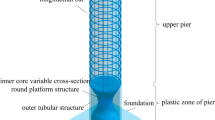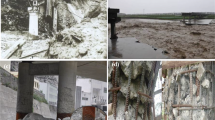Abstract
The Dujiangyan-Wenchuan highway serves as a vital passage to and from the region severely damaged by the 5.12 Wenchuan Earthquake in China. Chediguan Bridge is located on the highway and spans the Minjiang River. During the earthquake, the bridge was severely destroyed by rockfalls. Although the bridge was subsequently rebuilt and opened to traffic on May 12, 2009, it was destroyed again on July 25, 2009 by rock avalanches that had been located perilously high on the right bank of the Minjiang River, and caused deaths, casualties, and roads being cut off. A subsequent investigation revealed multiple perilous rocky areas on the massif along the Minjiang river bank, indicating an extremely high risk of another rockfall hazard, which could, again, lead to damage to the bridge and a further disastrous outcome. To mitigate the rockfall hazard to the bridge, a new flexible, energy-dissipating crashworthy device for bridge piers is developed to withstand the impact of rockfall. Numerical simulations using nonlinear finite element analysis was carried out to simulate the rockfall impact process on bridge piers. The following influencing factors during the impact process were taken into account: material nonlinearity, geometric nonlinearity, as well as contact nonlinearity. The results show that the new protective structure of bridge piers can effectively buffer rockfall impacts and significantly improve the anti-impact capability of the bridge piers.















Similar content being viewed by others
References
Bhatti AQ, Kishi N (2010) Impact response of RC rock-shed girder with sand cushion under falling load. Nucl Eng Des 240(10):2626–2632
Bhatti AQ, Kishi N, Mikami H (2011) An applicability of dynamic response analysis of shear-failure type RC beams with lightweight aggregate concrete under falling-weight impact loading. Mater Struct 44(1):221–231
Bourrier F, Dorren L, Nicot F, Berger F, Darve F (2009) Toward objective rockfall trajectory simulation using a stochastic impact model. Geomorphology 110(3):68–79
Broadhouse BJ, Neilson AJ (1987) Modelling reinforced concrete structures in DYNA3D. Report no. AEEW-M--2465. United Kingdom Atomic Energy Authority (UKAEA)
Calvert KL, Trumble KP, Webster TJ, Kirkpatrick LA (2010) Characterization of commercial rigid polyurethane foams used as bone analogs for implant testing. J Mater Sci Med 21(5):1453–1461
Chan KS (2000) A fracture mechanics-based model for assessing the mechanical failure of nuclear fuel rods due to rock fall. Nucl Eng Des 201(2):209–226
Chau KT, Wong RHC, Wu JJ (2002) Coefficient of restitution and rotational motions of rockfall impacts. Int J Rock Mech Min Sci 39(1):69–77
Consolazio GR, Cowan DR (2003) Nonlinear analysis of barge crush behavior and its relationship to impact resistant bridge design. Comput Struct 81(8–11):547–557
Consolazio GR, Cowan DR (2005) Numerically efficient dynamic analysis of barge collisions with bridge piers. J Struct Eng 131(8):1256–1266
Crosta GB, Agliardi F (2003) A methodology for physically based rockfall hazard assessment. Nat Hazards Earth Syst Sci 3(5):407–422
Delhomme F, Mommessin M, Mougin JP, Perrotin P (2005) Behavior of a structurally dissipating rock-shed: experimental analysis and study of punching effects. Int J Solids Struct 42(14):4204–4219
Delhomme F, Mommessin M, Mougin JP, Perrotin P (2007) Simulation of a block impacting a reinforced concrete slab with a finite element model and a mass-spring system. Eng Struct 29(11):2844–2852
Gentilini C, Gottardi G, Govoni L, Mentani A, Ubertini F (2013) Design of falling rock protection barriers using numerical models. Eng Struct 50:96–106
Giacomini A, Thoeni K, Lambert C, Booth S, Sloan SW (2012) Experimental study on rockfall drapery systems for open pit highwalls. Int J Rock Mech Min Sci 56:171–181
Hansson H, Skoglund P (2001) Modeling of steel behavior with application to armor penetration
He S, Wu Y, Yang X (2008) Study of rock-fall motion on slope. Chin J Rock Mech Eng S1
He SM, Wu Y, Li XP (2009) Research on restitution coefficient of rock fall. Rock Soil Mech 30(3):263–267
He SM, Shen J, Wu Y (2011) Rock shed dynamic response to impact of rock-fall. Rock Soil Mech 32(3):781–788
Japan Road Association (2000) Rockfall mitigation handbook (in Japanese)
Kishi N, Konno H, Ikeda K, Matsuoka KG (2002) Prototype impact tests on ultimate impact resistance of PC rock-sheds. Int J Impact Eng 27(9):969–985
Lambert S, Bourrier F (2013) Design of rockfall protection embankments: a review. Eng Geol 154:77–88
Lambert S, Gotteland P, Nicot F (2009) Experimental study of the impact response of geocells as components of rockfall protection embankments. Nat Hazards Earth Syst Sci 9:459–467
Luqing Z, Bing X, Yanjun S, Jiewang Z, Zhifa Y (2004) Engineering geological investigation and assessment on rockfall hazard along BaSu-LinZhi section of south line of Sichuan-Tibet highway. Chin J Rock Mech Eng 9:029
Pichler B, Hellmich C, Mang HA (2005) Impact of rocks onto gravel design and evaluation of experiments. Int J Impact Eng 31(5):559–578
Ronco C, Oggeri C, Peila D (2009) Design of reinforced ground embankments used for rockfall protection. Nat Hazards Earth Syst Sci 9(4):1189–1199
Sasiharan N, Muhunthan B, Badger TC, Shu S, Carradine DM (2006) Numerical analysis of the performance of wire mesh and cable net rockfall protection systems. Eng Geol 88(1–2):121–132
Sha Y, Hao H (2012) Nonlinear finite element analysis of barge collision with a single bridge pier. Eng Struct 41:63–76
Sha Y, Hao H (2013) Laboratory tests and numerical simulations of barge impact on circular reinforced concrete piers. Eng Struct 46:593–605
Shu S, Muhunthan B, Badger TC (2005) Snow loads on wire mesh and cable net rockfall slope protection systems. Eng Geol 81(1):15–31
Spadari M, Giacomini A, Buzzi O, Fityus S, Giani GP (2012) In situ rockfall testing in New South Wales, Australia. Int J Rock Mech Min Sci 49:84–93
Thoeni K, Giacomini A, Lambert C, Sloan SW, Carter JP (2014) A 3D discrete element modelling approach for rockfall analysis with drapery systems. Int J Rock Mech Min Sci 68:107–119
Valagussa A, Frattini P, Crosta GB (2014) Earthquake-induced rockfall hazard zoning. Eng Geol 182:213–225
Van Tran P, Maegawa K, Fukada S (2013) Prototype of a wire-rope rockfall protective fence developed with three-dimensional numerical modeling. Comput Geotech 54:84–93
Volkwein A, Schellenberg K, Labiouse V, Agliardi F, Berger F, Bourrier F, Dorren LK, Gerber W, Jaboyedoff M (2011) Rockfall characterisation and structural protection—a review. Nat Hazards Earth Syst Sci 11:2617
Wang L, Yang L, Huang D, Zhang Z, Chen G (2008) An impact dynamics analysis on a new crashworthy device against ship–bridge collision. Int J Impact Eng 35(8):895–904
Wang DP, He SM, Li XP, Xiang B (2012) Study on the dissipating effects of shed with EPS cushion under impact load. J Sichuan Univ Eng Sci Ed 44(6):102–107
Wei LW, Chen H, Lee CF, Huang WK, Lin ML, Chi CC, Lin HH (2014) The mechanism of rockfall disaster: a case study from Badouzih, Keelung, in northern Taiwan. Eng Geol 183:116–126
Yang M, Qiao P (2010) Analysis of cushion systems for impact protection design of bridges against overheight vehicle collision. Int J Impact Eng 37(12):1220–1228
Yuan JK, Li YR, Huang RQ, Pei XJ (2015) Impact of rockfalls on protection measures: an experimental approach. Nat Hazards Earth Syst Sci 15(4):885–893
Acknowledgements
This work was supported as a joint research project by the National Natural Science Foundation of China (grant no.41790433), NSFC-ICIMOD (grant no. 41661144041) and the Science and Technology Department of Sichuan Province of China (grant no. 2016SZ0067), Key Research and Development Projects of Sichuan Province (grant no. 2017SZ0041) as well as the research and development plan project for science and technology of the Ministry of Railways (Z2012-061, CLRQT-2015-012, 2012-Major-3).
Author information
Authors and Affiliations
Corresponding author
Rights and permissions
About this article
Cite this article
He, S., Yan, S., Deng, Y. et al. Impact protection of bridge piers against rockfall. Bull Eng Geol Environ 78, 2671–2680 (2019). https://doi.org/10.1007/s10064-018-1250-5
Received:
Accepted:
Published:
Issue Date:
DOI: https://doi.org/10.1007/s10064-018-1250-5




